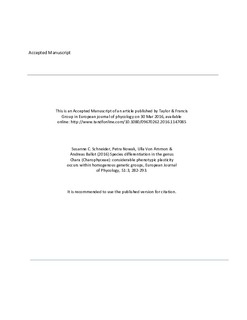| dc.description.abstract | Charophytes are benthic algae with a complex morphology and high phenotypic plasticity. This has led to ambiguities in species delineation. However, until now genetic studies on Chara have been based on samples collected from a restricted geographic range or only included a restricted number of taxa. This may have hindered a general interpretation of the results. We applied barcoding of matK, a rapidly evolving coding section of the plastid genome, in 324 Chara samples collected from 19 countries, in order to test whether the distribution of barcode haplotypes among individuals was consistent with species boundaries as they are currently understood. The phylogenetic tree grouped the 324 Chara individuals, which according to commonly used identification keys represented 29 species, into 12 well-defined groups (i.e. monophyletic morphospecies or groups of morphospecies). Considerable morphological variation occurred within genetically homogeneous groups. This included traits which are commonly used for Chara species determination, such as the length and number of spine cells, the length of stipulodes and bract cells, cortication (tylacanthous, isostichous, aulacanthous and absent cortication), as well as sex differentiation. However, there were also substantial genetic differences among morphologically similar species (e.g. C. virgata – C. globularis – C. connivens). No morphological trait consistently reflected genetic differences. This indicates that morphological traits for specific taxa may serve as diagnostic tools for species delimitation, but that they are not generally suitable for inferring genetic differentiation or phylogenetic relationships. We propose that (i) C. virgata and C. strigosa, (ii) C. liljebladii, C. horrida and C. baltica, and (iii) C. hispida, C. rudis and C. polyacantha are conspecific. Our data also indicate that C. gymnophylla should be divided into tylacanthous forms (which are closely related to C. contraria) and aulacanthous forms (which are related to C. vulgaris). | nb_NO |
